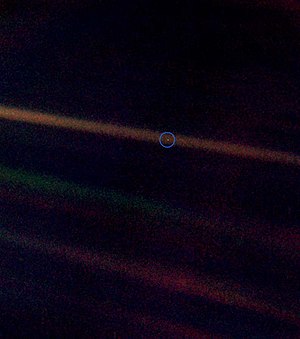May 9th 2015 will see the inauguration of Cornell University's new Institute for Pale Blue Dots. Details here.
The first image of a "pale blue dot" was sent back by Voyager 1. The "dot" is a single pixel.
"all of human history has happened on that tiny pixel, which is our only home"
Carl Sagan, speech at Cornell University, October 13th 1994

Image courtesy Wikipedia.
Although the Dotties Institute is yet to be inaugurated the web site already has some extremely interesting materials. The latest, posted December 4th 2014 is entitled: How To Find An Infant Earth. A short abstract follow:

Finding Infant Earths and Potential Life Just Got EasierOf course, in the search for pale blue dots, every Dottie needs one of these:
Among the billions and billions of stars in the sky, where should astronomers look for infant Earths where life might develop? New research from Cornell University’s Institute for Pale Blue Dots shows where – and when — infant Earths are most likely to be found. The paper by research associate Ramses M. Ramirez and director Lisa Kaltenegger, “The Habitable Zones of Pre-Main-Sequence Stars” is forthcoming in Astrophysical Journal Letters.“The search for new, habitable worlds is one of the most exciting things human beings are doing today and finding infant Earths will add another fascinating piece to the puzzle of how ‘Pale Blue Dots’ work” says Kaltenegger, associate professor of astronomy in Cornell’s College of Arts and Sciences.
The researchers found that on young worlds the Habitable Zone, the orbital region where water can be liquid on the surface of a planet and where signals of life in the atmosphere can be detected with telescopes, turns out to be located further away from the young stars these worlds orbit than previously thought.

The world's biggest eye on the sky
Extremely Large Telescopes are considered worldwide as one of the highest priorities in ground-based astronomy. They will vastly advance astrophysical knowledge, allowing detailed studies of subjects including planets around other stars, the first objects in the Universe, super-massive black holes, and the nature and distribution of the dark matter and dark energy which dominate the Universe.
Since the end of 2005 ESO has been working together with its user community of European astronomers and astrophysicists to define the new giant telescope needed by the middle of the next decade.
Dubbed E-ELT for European Extremely Large Telescope, this revolutionary new ground-based telescope concept will have a 39-metre main mirror and will be the largest optical/near-infrared telescope in the world: “the world’s biggest eye on the sky”.
The eye on the sky seemed like pie in the sky until funding became available. The go-ahead to build was announced December 4th 2014.
At a recent meeting ESO’s main governing body, the Council, gave the green light [1] for the construction of the European Extremely Large Telescope (E-ELT) in two phases. Spending of around one billion euros has been authorised for the first phase, which will cover the construction costs of a fully working telescope with a suite of powerful instruments and first light targeted in ten years time. It will enable tremendous scientific discoveries in the fields of exoplanets, the stellar composition of nearby galaxies and the deep Universe. The largest ESO contract ever, for the telescope dome and main structure, will be placed within the next year.
The E-ELT will be a 39-metre aperture optical and infrared telescope sited on Cerro Armazones in the Chilean Atacama Desert, 20 kilometres from ESO’s Very Large Telescope on Cerro Paranal. It will be the world’s largest “eye on the sky”.
Carl Sagan - Pale Blue Dot
Footnote
The term "Dottie" is not intended to be at all derogatory. I would count myself honoured if I were a member of the Dotties Institute.



Comments